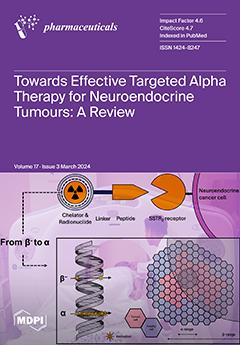This article reports on the synthesis of nine promising new 1,3,4-thiadiazole derivatives based on 3-aminopyridones, containing various acidic linkers. The synthesis was carried out by cyclizing the corresponding thiohydrazides
4a–
c and anhydrides of glutaric, maleic, and phthalic acids upon heating in
[...] Read more.
This article reports on the synthesis of nine promising new 1,3,4-thiadiazole derivatives based on 3-aminopyridones, containing various acidic linkers. The synthesis was carried out by cyclizing the corresponding thiohydrazides
4a–
c and anhydrides of glutaric, maleic, and phthalic acids upon heating in acetic acid solution. The conducted bio-screening of the synthesized new 1,3,4-thiadiazole derivatives containing different acidic linkers (butanoic, acrylic, and benzoic acids) showed that they have significant inhibitory activity against
α-glucosidase (up to 95.0%), which is 1.9 times higher than the value for the reference drug acarbose (49.5%). Moreover, one of the 1,3,4-thiadiazole derivatives with a benzoic acid linker—2-(5-((6-Methyl-2-oxo-4-(thiophen-2-yl)-1,2-dihydropyridin-3-yl)carbamoyl)-1,3,4-thiadiazol-2-yl)benzoic acid (
9′b)—showed an IC
50 value of 3.66 mM, nearly 3.7 times lower than that of acarbose (IC
50 = 13.88 mM). High inhibitory activity was also shown by 1,3,4-thiadiazole derivatives with a butanoic acid linker (compounds
7b,
7c)—with IC
50 values of 6.70 and 8.42 mM, respectively. A correlation between the structure of the compounds and their activity was also established. The results of molecular docking correlated well with the bioanalytical data. In particular, the presence of a butanoic acid linker and a benzoic fragment in compounds
7b,
7c, and
9b increased their binding affinity with selected target proteins compared to other derivatives
3–
6 (
a–
c). Calculations according to Lipinski’s rule of five also showed that the synthesized compounds
7b,
7c, and
9b fully comply with Ro5 and meet all criteria for good permeability and acceptable oral bioavailability of potential drugs. These positive bioanalytical results will stimulate further in-depth studies, including in vivo models.
Full article






